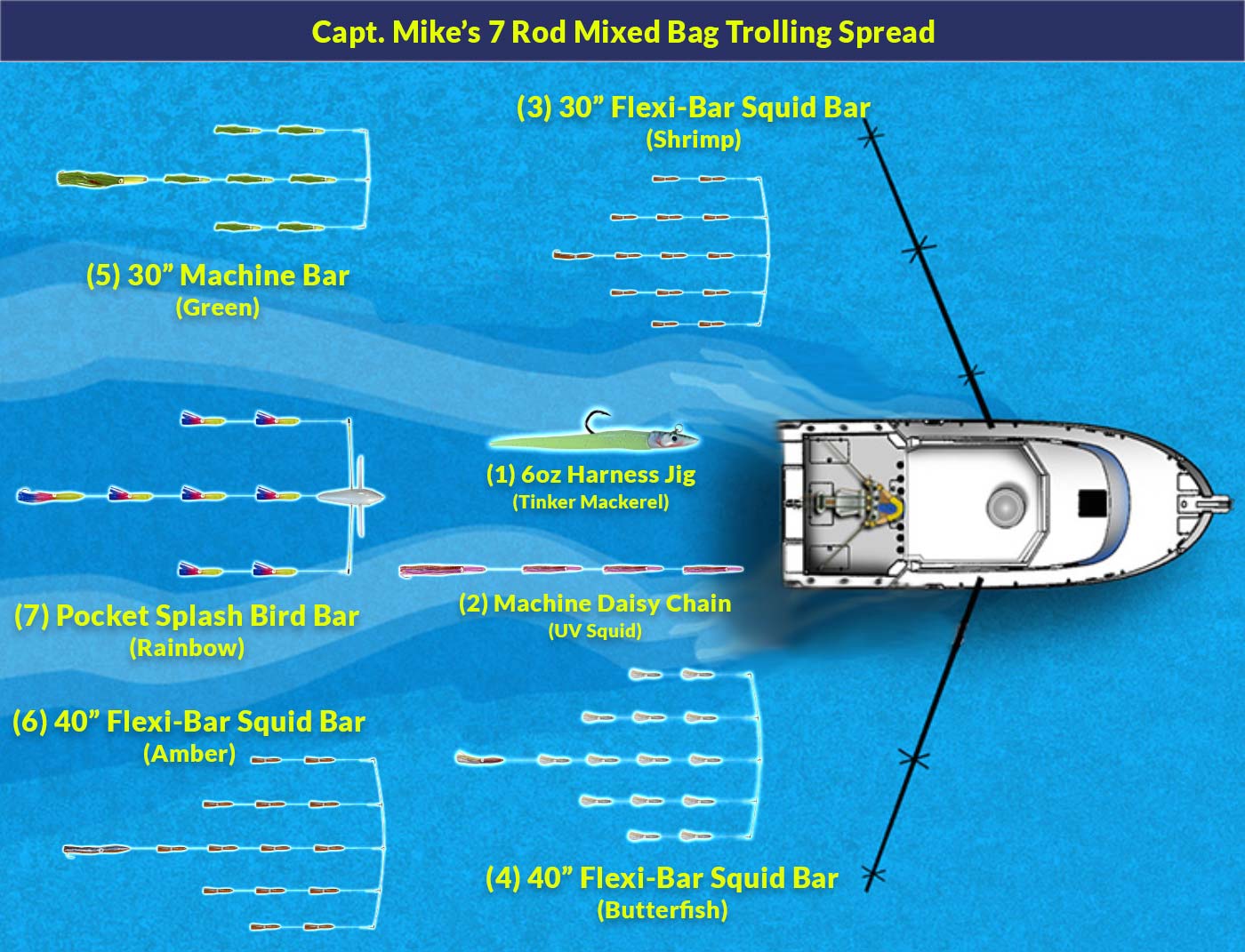Offshore lures are often referred to collectively as a spread. Like just about everything in life, there is more than one-way to skin the cat(fish). Here is a rundown of three classic spreads as I’ve learned from my years fishing south of the Martha’s Vineyard.
The Mixed Bag
7 Rod Mixed Bag Spread
(1) Tink Mack Harness Jig
(2) Pink Squid Machine Chain
(3) 30” Flexi-Bar Squid Bar (Shrimp)
(4) 40″ Flexi-Bar Squid Bar (Butterfish)
(5) 30” Machine Bar (Green)
(6) 9” Bulb Squid Daisy Chain (Amber)
(7) Pocket Machine Bar (Rainbow)
This is probably the most common spread on the water but not always by design. I’ve noticed more than a few times on other people’s boats that mixed bag spreads are a collection of “lucky lures” that have been successful from different trips for different reasons. Speaking to this point, I strongly recommend having a strategy behind the mixed bag spread to significantly up your game.
I think there is really two strategies that can be discussed here:
(1) IF IT AIN’T BROKE, DON’T FIX IT: If you have a spread that works for you and your confidence is high with it, don’t mess with it. You’ll hear captain’s talk about the “integrity of the spread” and they keep the spread unchanged with the idea that the combination is working, so don’t mess with it.
(2) PROGRESSIVE SYSTEM: If you catch a fish on one color, you put the same spread back out. If you catch another fish on the same color, you take out one other color and add replace it with the “catch color” and keep up with the progressive system as you more fish on a certain color. Eventually, you spread will morph into a carpet bomb. NOTE: Remember the concept of integrity of the spread. If you stop catching, reverse your steps, there may have been something the tuna liked about your varied spread.
Pros and Cons:
• Pros: This spread is for the commitment-phobe. Basically you’re hedging your bet on colors.
• Cons: Critics might argue that the spread looks less natural as it is unlikely to see a school of mixed baitfish.
When to Use:
• When you don’t know what the tuna you are targeting are eating.
• When you only carry one spread
Carpet Bomb Spread(s)
Green Carpet Bomb Spread
(1) Green Mini Jet
(2) Chrome Silver Harness Jigs
(3) 30” Green Mack Ultra Flex Bar
(4) 30” Zucchini Ultra Flex Bars
(5) 30” Green Machine Bar
(6) Green Machine Bird Bar
(7) Bird + Chart Blue Max Combo
(8 – Optional) Green Machine Daisy Chain
Rainbow Carpet Bomb Spread
(1) Rainbow Mini Jet
(2) Chrome Silver Harness Jigs
(3) 30” Rainbow Ultra Flex Squid Bar
(4) 30” Rainbow Machine Bar
(5) 30” Rainbow Bird Machine Bar
(6) Bird plus 9” Amber Squid Chain
(7) Bird + Green Chart Blue Max Combo
(8 – Optional) Rainbow Daisy Chain
The whole concept of the carpet bomb is to have matching lures to simulate a school of bait. This method works best with an 8-rod spread, but if you only have 6 rods, it will work too. Even if you are using different lure types, you match all the colors closely with the exception of one contrasting off color lure, which is often the one to get hit.
Pros and Cons
• Pros: The carpet bomb looks very real. So real, that even if the fish are feeding on something entirely different, you may have enough critical mass to create your own feed, even if it’s against the grain.
• Cons: Sometimes they are “off” on a particular color. If you’re using that color, you are out of luck!
When to Use
• Great for when you know what the tuna are keyed in on from reports or past experiences. I typically start with a Mixed bag or Hybrid Spread and morph into a carpet bomb.
Hybrid Spread(s)
Natural Hybrid Spread
(1) Sand Eel Harness Jig
(2) Chrome Silver Harness Jig
(3) 40” Shrimp Ultra Flex Bar
(4) 40” Green Mack Ultra Flex Bar
(5) 40” Butter Fish Ultra Flex Bar
(6) 40” Shrimp Fish Ultra Flex
(7) 9” Green Machine Bird Bar
(8 – Optional) 9” Blurple Squid Daisy Chain with Bird.
Rainbow Hybrid Spread
(1) Pink Harness Jig
(2) Green Harness Jig
(3) 40” Green Mack Ultra Flex Bar
(4) 40” Rainbow Ultra Flex Bar
(5) 40” Zucchini Ultra Flex Bar
(6) 40” Blurple Ultra Flex
(7) 9” Green Machine Bird Bar
(8 – Optional) 9” Blurple Squid Daisy Chain with Bird.
Pros and Cons
• Pros: Your bets are really hedged because you will be using a variety of colors through out the day. But more importantly, It’s my experience that bait tends to rise to the surface early in the day and tends go deeper as the day goes on. The natural colors will help match the hatch and the attractor colors will help draw fish in later in the day. It follows the conventional wisdom for all lure fishing which suggests your bet is to use bright colors for bright conditions and darker colors for darker conditions.
• Cons: Sometimes they are “off” on a particular color. If you’re using that color, you are out of luck!
When to Use
• Over the past 2 seasons (2104 and 2015) I followed this method just about every trip and I have had the best 2 seasons I can remember. (Compared to other anglers in the fleet) It covers all your bases and works!
• I will tend to stick with the natural colors all day in rain and fog and use attractor colors all day in rough seas when lures might be hard to find.







